Introduction
The Kuwaiti government has introduced a policy that seeks to provide equal education opportunities to all children. As such, the country’s leadership is promoting the English language to sustain its growth and development (Zheng 2009).
The rationale underpinning this strategy is that English has become the Lingua Franca of the contemporary world (Pajeres 2013). The Ministry of Education has mandated its institution of higher education and schools to teach English as a Foreign Language (EFL).
The purpose of this goal is to enhance the proficiency and competencies of English at every level of education (Nizonkiza 2011).
The findings from a recent study have shown that the majority of Kuwaiti students are incapable of communicating efficiently in English once they transition from the primary classes (Karathanos 2009).
According to Pajeres (2013), these students are weak in both written and spoken English once they transition from the elementary classes.
This state of incompetence has raised questions over the incapacity of teachers to provide adequate instruction. Nizonkiza (2011) has examined the manner in which Kuwait trains its English instructors.
The aim of this research was to explore the association between the beliefs of teachers and the intake of vocabulary. The pursuit of the previous objective entailed answering the following research questions:
- How do primary school teachers in Kuwait perceive the vocabulary teaching in their content area?
- Are the teachers’ beliefs about vocabulary teaching in harmony with the current research on lexicon instruction and development?
- Are the teaching practices among Kuwaiti primary school teachers sufficient to facilitate vocabulary intake?
- Do the teachers transmit vocabulary knowledge using techniques that encourage both active learning and processing?
The preceding discussions have laid the foundation for the study by highlighting the need to explore teachers’ beliefs. The second part of this report will provide a brief review of the literature on the same subject matter.
The methodology section will identify the approaches that the researcher used to collect and analyse raw data. The fourth section will outline the primary findings of the research. The final section will discuss the principal findings from the study, which will include implications for practice and a conclusion.
Literature Review
The worldviews and perceptions of teachers influence the delivery of education content significantly (Ezzi 2012; Teik 2011; Wright 2010). The teachers’ beliefs about foreign language teaching and learning have elicited a lot of interest among researchers in the area of language acquisition.
One of the areas that have received significant attention is the influence of teachers’ beliefs on classroom practices (Wright 2010). For instance, Ezzi (2012) has found out that most teachers have clear theoretical assumptions that have a direct effect on their preferred teaching techniques.
Individual beliefs and attitudes are very powerful in predicting the manner in which teachers behave in the classroom (Pajares 2013). In addition, Barnard and Scampton (2008) have indicated that these components determine how people conceptualise and solve problems.
Leno and Dougherty (2007) have asserted that the tutors’ perceptions about the teaching or learning process ascertain whether students will succeed or fail to master a foreign language.
Ghaffarzadeh (2012b) has noted that attitudes constitute a central construct, which defines human behaviour. According to Yan (2009), these beliefs influence attitudes, policies, techniques and learners’ development.
A large body of studies conducted over the past two decades focused more on learning beliefs and self-efficacy (Brand & Wilkins 2007; Ezzi 2012). The recent investigations have explored pedagogical ideas to find out if teachers have similar or different viewpoints.
For instance, Zheng (2009) has suggested that novice teachers often view teaching as the process of transmitting information to passive learners directly. Barnard and Scampton (2008) have indicated that the multiplicity of attitudes among teachers affects instructional strategies and classroom management practices.
Methodology
The study included five teachers from a primary school in Kuwait. The researcher had intended to interview ten teachers but only five volunteered to participate in the study.
One of the teachers was responsible for coordinating literacy instruction based on the school’s policy guidelines. The others were teaching English as a Foreign Language between grades one and five.
The head teacher approved the research but was not available for the interview because of official duties.
Research Design and Approach
This study adopted the descriptive research design to map the terrain for exploring the phenomenon of interest. The descriptive study design was also essential to identify the associations between the teachers’ perceptions and vocabulary intake.
On the other hand, the research employed the quantitative approach to examining the beliefs and attitudes of the primary school teachers objectively. The choice of the quantitative methodology facilitated the development of a well-conceptualized research process.
Data Collection Techniques
The research used a mixed-method approach to gathering crucial information. The rationale behind this strategy was to triangulate the research findings. Firstly, the participants completed a written questionnaire. The survey contained multiple questions using the five Likert scale items.
The Likert rating scale was essential to measure the frequency with which the teachers were employing different English instruction strategies. Each of the participants responded to a set of questions that assessed how they were using different instructional techniques.
Secondly, the researcher also used semi-structured face-to-face interviews to validate the information generated from the survey. The open-ended questions were necessary to seek supplementary insights through further probing. In addition, this strategy was crucial to seek clarifications in the case of vague answers.
The interviews took place in a private room once the participants were through with their classes. The interview schedule contained questions that evaluated the teachers’ level of training, self-efficacy and beliefs.
Finally, the researcher observed the teachers as they provided English instruction in the classroom. The formal teacher observation during the English lessons was critical to determine classroom practices.
This technique was also crucial to validate the findings using first-hand information. The researcher sought the consent of the teachers prior to using any of these techniques.
Data Analysis Strategies
The quantitative data from the questionnaires and interviews has been analysed using the SPSS software. The SPSS outputs generated charts and frequency tables to make sense of the raw data. The face-to-face interviews provided qualitative data, which has been organized under three themes.
The first category will provide information about the teachers’ scope of training in English instruction, including the instructional techniques. The second and third groups deal with the issues of self-efficacy and beliefs respectively. It is imperative to note that this analysis is based on the participants’ individual responses.
Results
Demographic Data
The five teachers included in the research were of the female gender. The teachers had different years of experience in English instruction (Figure 1). The number of years ranged between 4 and 10 with a mean of 6.4 years. The participants were teaching in different grades although all of them have taught in grades one to five.
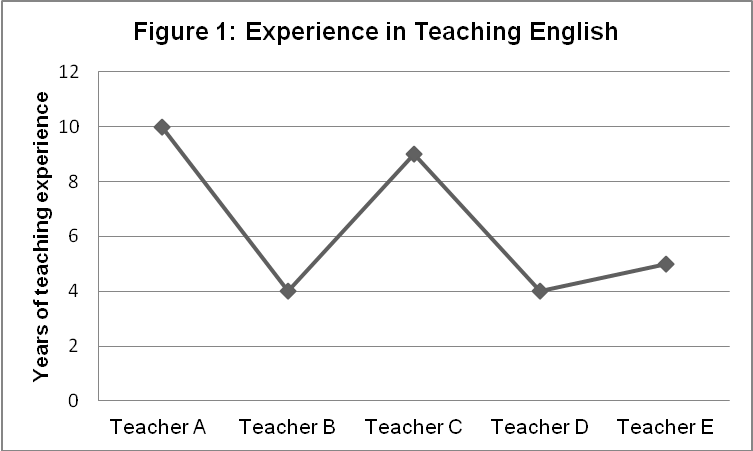
The figure above illustrates the teachers’ years of experience in teaching English at a primary school level. The analysis indicated that the participants’ level of confidence increased with the number of years.
This trend was evident in their teaching practices and approaches. For example, Teacher A was more adept at using the modelling technique compared to the other teachers.
The Scope of Training
The scope of training emerged as a one of the critical components influencing classroom instruction and practices. Four teachers were native Kuwaitis while the remaining one was of a mixed race (British-Kuwaiti). It was essential to find out if these teachers had received any formal instruction in English.
The British-Kuwaiti was more skilled in English because she started learning the language before enrolling in school. On the other hand, three teachers commenced English classes at the age of ten. The remaining teacher did not learn English until the time she was in the 12th grade.
In addition, three teachers (A, B and D) did not receive training on how to teach vocabulary while studying at the University. For example, Teacher D majored in translation and linguistics.
The other two teachers (C and E) received formal training at the University. These facts were explored further by asking the participants to rate their vocabulary knowledge on a scale of 1-5 (Figure 2).
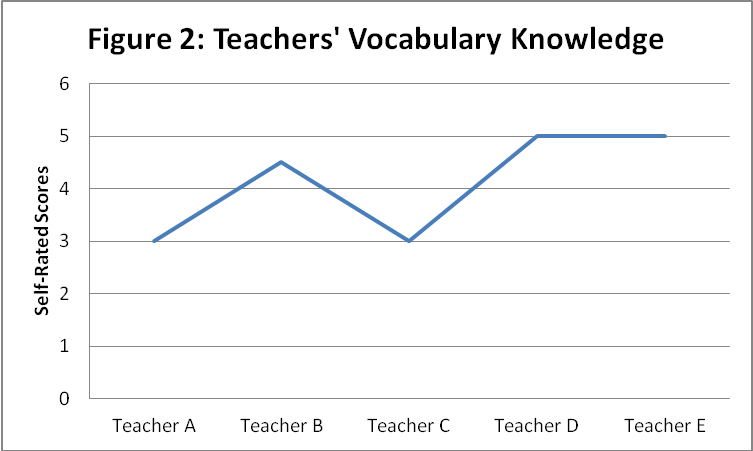
Figure 2 illustrates the self-rated scores about the teachers’ vocabulary knowledge with a mean score was 4.1. The three teachers who had the highest rating (above 4.5) also felt that their teaching techniques were useful. The teachers were asked if they required additional training in vocabulary instruction (Figure 3).
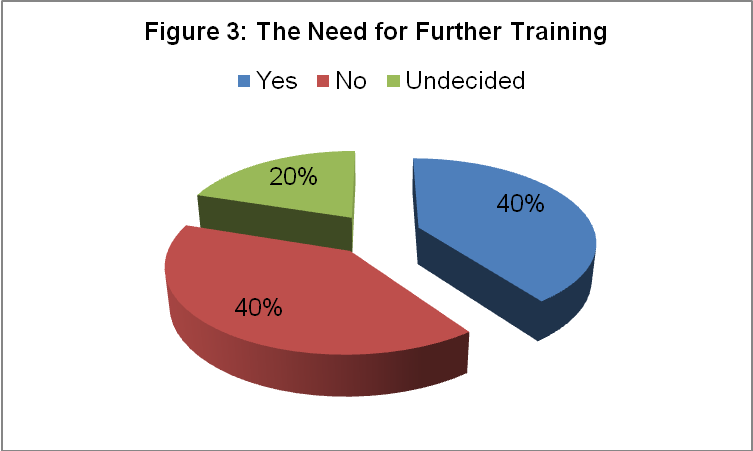
Three teachers underscored the need to undergo further training in vocabulary while two opposed the idea. Teacher E was receptive to continuous education because of the need to learn the modern and sophisticated models of pedagogy.
Teacher D was adamant about further education although she felt that this was a good suggestion.The teachers were then required to identify the areas of vocabulary instruction that they find to be more difficult (Figure 4).
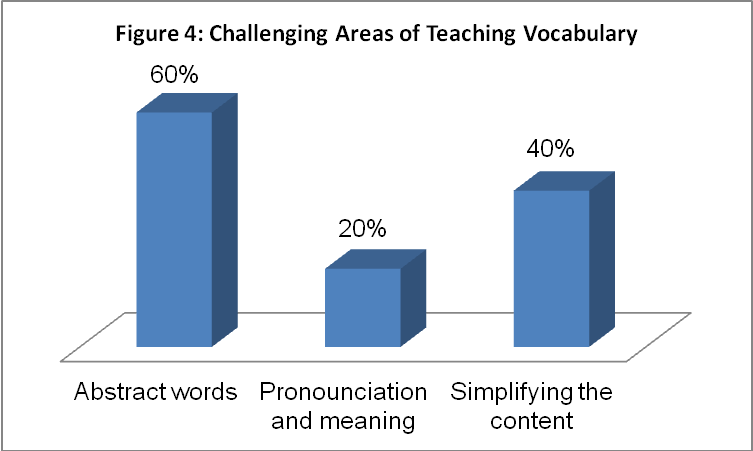
The majority of the teachers (60%) found it more challenging to teach abstract words. Teacher B was finding it more difficult to learn pronunciation and meanings.
On the other hand, two teachers (A and C) reported facing a myriad of obstacles in simplifying the learning content. The researcher then asked the teachers to identify the techniques they employ considering these challenges (Figure 5). The survey also explored this issue based on the vocabulary teaching style inventory.
The findings presented in Figure 5 above indicate that the teachers were using exemplars and switching language (between Arabic and English) more frequently.
These two techniques were found to be more effective in supporting vocabulary intake. Classroom models and aids (especially flash cards and modelled behaviour) were also prominent. One of the teachers (Teacher C) was using videos and pictures to enhance the teaching process.
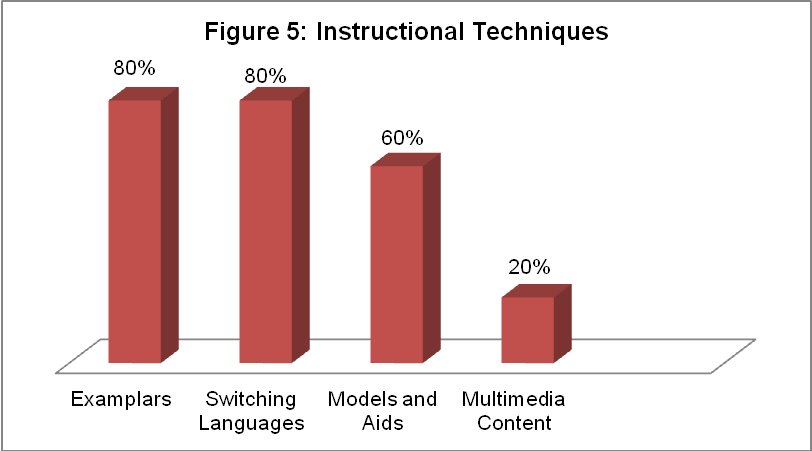
The Teachers’ Self-Efficacy
The teachers were also evaluated on their level of self-confidence in teaching English as a foreign language. The participants rated their self-efficacy on a scale of 1-5 (Figure 6). The purpose of this activity was to determine if self-confidence has an effect on teachers’ beliefs.
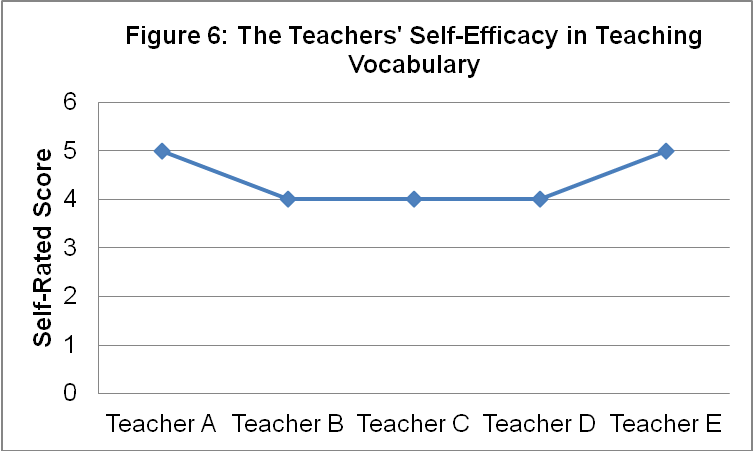
According to the figure above, all the teachers were confident in teaching vocabulary (the mean score was 4.4). The majority of the participants (80%) indicated that adequate preparation prior to teaching increased their level of self-efficacy.
In addition, Teacher C and E were using the skills they acquired at the university had increased their self-esteem. Overall, all the teachers felt that adequate and appropriate instructional materials reduce anxiety and fear.
The Teachers’ Beliefs
The principal purpose of this study was to determine how teachers’ beliefs influence vocabulary intake. Accordingly, the researcher explored this aspect by asking the teachers to rate their attitudes about teaching English to Kuwaiti students (Figure 7).
The average score was 4.4, meaning that the teachers had positive beliefs regarding the instruction of English as a foreign language. The participants gave varied reasons to support their insights.
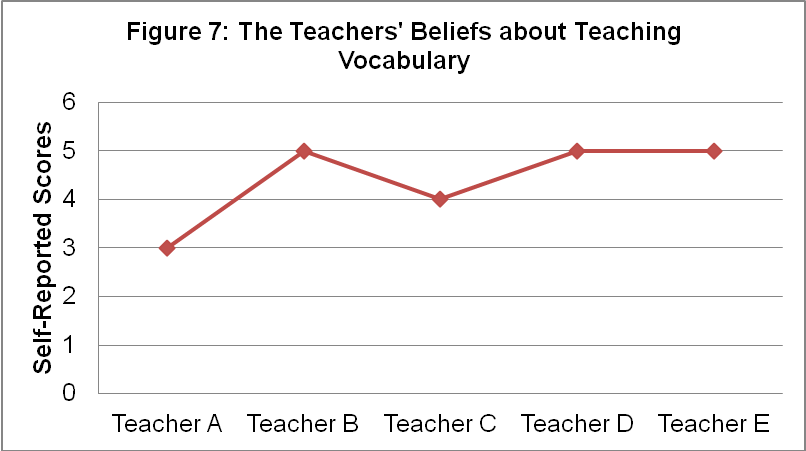
Most teachers (80%) argued that English instruction was essential to support other subjects. For example, Teacher B indicated that English complements science instruction because the latter is a universal subject.
In addition, Teacher C showed that the unprecedented advances in technology mandates the students to have requisite skills in English. She gave the example of the iPad, which is one of the greatest innovations in the technological industry.
On the other hand, all the teachers supported the use of formal tests to examine the students’ skills in both written and spoken English.
Discussions
Analysis and inferences
The first theme of the findings underscored the significance of formal education and training in English instruction. Three of the five teachers had not received any formal training in vocabulary while studying at the University. This limitation was affecting the choice of teaching techniques.
The instructors were finding it difficult to teach abstract words. Another teacher could not develop the best strategies to simplify the learning content. These findings highlighted the need for further training, which receive support from most teachers.
These results were consistent with those from previous studies. For instance, Pajeres (2013) has found that the high education system in Kuwaiti is inadequate to meet the demands of English instruction.
Fleming, Bangou and Fellus (2011) have asserted that inappropriate training contributes to the adoption of unproductive classroom practices.
Secondly, self-efficacy emerged as a critical aspect of English instruction. The teachers rated their level of confidence highly for two reasons.
First, prior and adequate preparation was essential to boost their self-esteem and conviction. Second, the two students who had received formal education in vocabulary instruction were more assertive than those who did not.
Thus, this study established a relationship between training and self-efficacy, which is consistent with the previous findings (Brand & Wilkins 2007). Adequate training plays a fundamental role enhancing self-confidence during classroom instruction (Phipps & Borg 2009; Watkins 2007; Wright 2007).
According to Bolton, Graddol and Meierkord (2011), the teachers who have received formal training in vocabulary instruction are more adept in adopting efficient teaching practices than those who have not.
Thirdly, this study has confirmed that teachers’ beliefs influence instruction practices. The teachers firmly believed that the Kuwaiti children should learn English as a second language. The elemental factor that supported the preceding assertion was the standpoint of English in the modern world.
One of the teachers indicated that the students require basic skills in the English language in order to adapt to the technological advances.
These results are similar with those in the reviewed literature. For example, Zheng (2009) has opined that English will become the language of choice in both political and commercial discourses.
The teachers had positive beliefs and attitudes about teaching vocabulary. The high regard for English as a foreign language was facilitating these teachers to develop sound instructional practices. The present research has indicated that the instructional methods were efficient in meeting the students’ learning outcomes.
Conversely, previous studies have shown that Kuwaiti EFL teachers are biased against the English language (Karathanos 2009; Nizonkiza 2011; Pajeres 2013). According to Nizonkiza, these prejudices have an adverse effect on the students because the teachers only teach for economic benefits.
Pajeres (2013) has asserted that Kuwaiti students have inadequate skills in both written and spoken English. The use of normative teaching techniques is one of the contributors to this dismal performance (Karathanos 2009).
Implications for practice
The findings from this study have established the significance of formal training and education in vocabulary teaching. Adequate and appropriate training is essential because it affects self-efficacy and perceptions. Thus, the Kuwaiti Ministry of Education should make concerted efforts to improve the current system of education.
Secondly, the school administrators should consider introducing in-house training programmes, which will be crucial to enhancing the teachers’ skills and competencies in English.
Conversely, this study analysed data from only five teachers. The small sample size means that the findings of this research cannot the extrapolated and generalized to other populations.
This study has provided the basis for conducting additional studies, which will include a larger sample drawn from multiple schools.
Conclusion
This research has established the fact that teachers’ beliefs and attitudes affect instruction practices, which subsequently influence vocabulary intake.
On the other hand, the level of training and education also plays a significant role in shaping these perceptions. The global politics and economies in the modern society require individuals who are proficient in both written and spoken English.
As such, it is essential to enhance the instruction of English as a foreign language in Kuwait. The realization of this goal necessitates the development of a foundational English syllabus emphasizes vocabulary intake, speaking skills, listening skills and grammar.
The English course content for both teachers and students should use authentic texts to address the socio-cultural aspects of learning.
Reference List
Barnard, R & Scampton, D 2008, ‘Teaching grammar: a survey of EAP teachers in New Zealand’, New Zealand Studies in Applied Linguistics, vol. 14, no. 2, pp. 59-82.
Bolton, K, Graddol, D & Meierkord, C 2011, ‘Towards developmental world Englishes. World Englishes, vol. 30, pp. 459–480.
Brand, B & Wilkins, J 2007, ‘Using self-efficacy as a construct for evaluating science and mathematics methods courses’, Journal of Science Teacher Education, vol. 18, no. 2, pp. 297-317.
Ezzi, NAA 2012, ‘Yemeni teachers’ beliefs of grammar teaching and classroom practices’, English Language Teaching, vol. 5, no. 8, pp. 170-184.
Fleming, D, Bangou, F & Fellus, O 2011, ‘ESL teacher-candidates’ beliefs about Language’, TESL Canada Journal, vol. 29, no. 1, pp. 39-56.
Ghaffarzadeh, HMA 2012a, ‘The effect of teachers’ lexicon teaching beliefs on EFL learners’ vocabulary Intake’, Journal of Education and Learning, vol. 1, no. 2, pp. 156-160.
Ghaffarzadeh, HMA 2012b, ‘Function-based vs Meaning-based beliefs in teaching vocabulary’, Bellaterra Journal of Teaching & Learning Language & Literature, vol. 5, no. 4, pp. 20-41.
Karathanos, K 2009, ‘Exploring US mainstream teachers’ perspectives on use of the native language in instruction with English language learner students’, International Journal of Bilingual Education and Bilingualism, vol. 12, no. 6, pp. 615-633.
Leno, LC & Dougherty, LA 2007, ‘Using direct instruction to teach content vocabulary’, Science Scope, vol. 31, no. 1, pp. 63-66.
Nizonkiza, D 2011, ‘The relationship between lexical competence, collocational competence, and second language proficiency’, English Text Construction, vol. 4, no. 1, pp. 113–145.
Pajares, MF 2013, ‘Teachers’ beliefs and educational research: cleaning up a messy construct’, Review of Educational Research, vol. 62, no. 3, pp. 307-332.
Phipps, S & Borg, S 2009, ‘Exploring tensions between teachers’ grammar teaching beliefs and practices’, System, vol. 37, pp. 380-390.
Teik, OC 2011, ‘Pre-service teachers’ beliefs about the teaching and learning of grammar’, The English Teacher, vol. 40, pp. 27-47.
Watkins, D 2007, ‘Learning and teaching: a cross-cultural perspective’, School Leadership and Management, vol. 20, no. 2, pp. 161-173.
Wright, T 2010, ‘Second language teacher education: review of recent research on practice’, Language Teaching, vol. 43, no. 3, pp. 259-296.
Wright, WE 2007, ‘Heritage language programs in the era of English-only and no child left behind’, Heritage Language Journal, vol. 5, no.1, pp. 1-26.
Yan, H 2009, ‘Student and teacher demotivation in ESL’, Asian Social Science, vol. 5 no. 1, pp. 109-112.
Zheng, H 2009, ‘A review of research on EFL pre-service teachers’ beliefs and practices’, Journal of Cambridge Studies, vol. 4, no. 1, pp. 73-81.